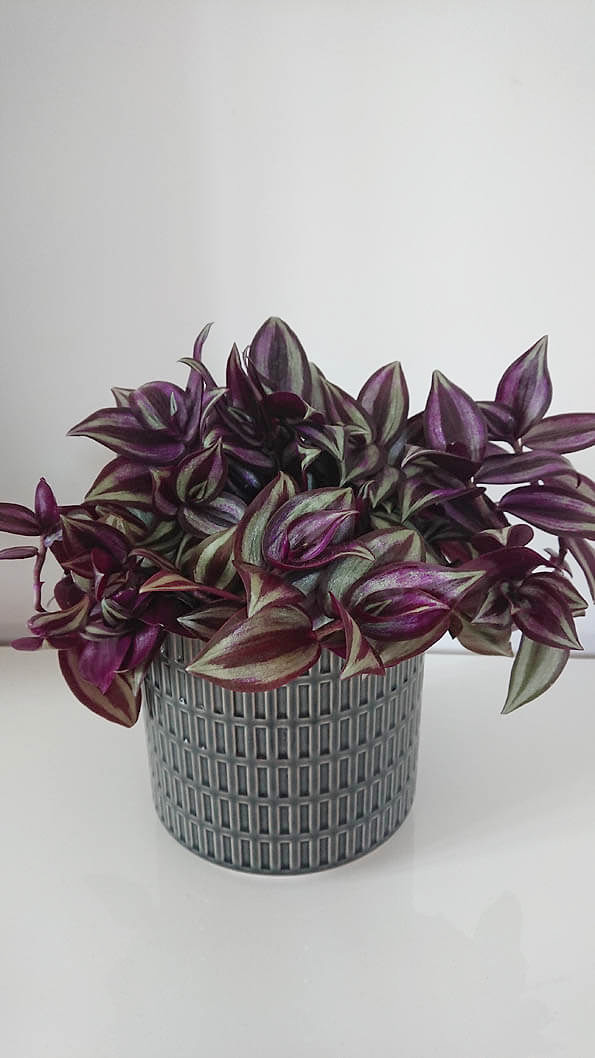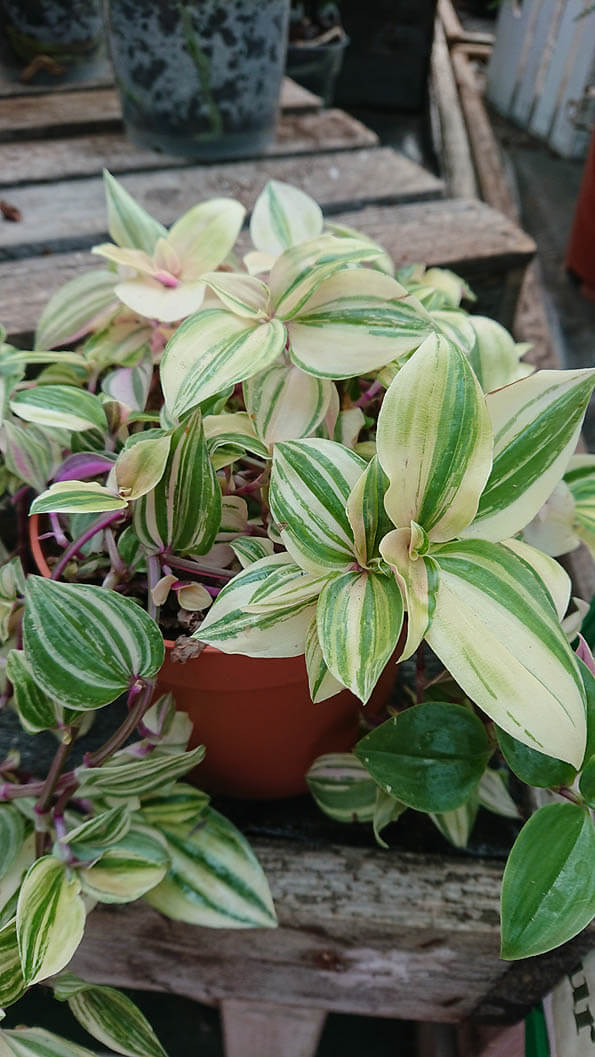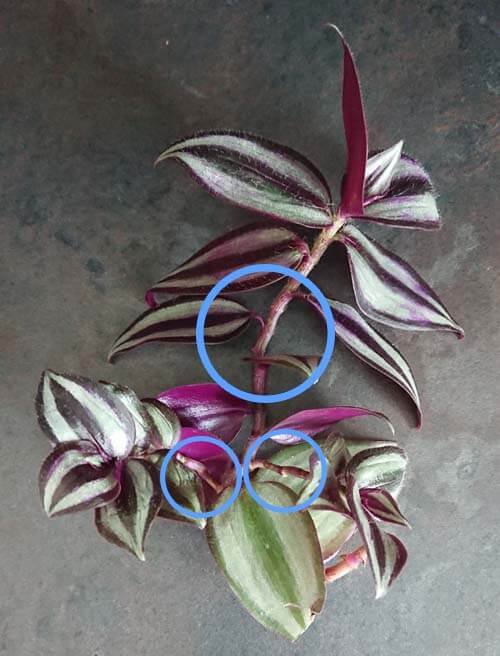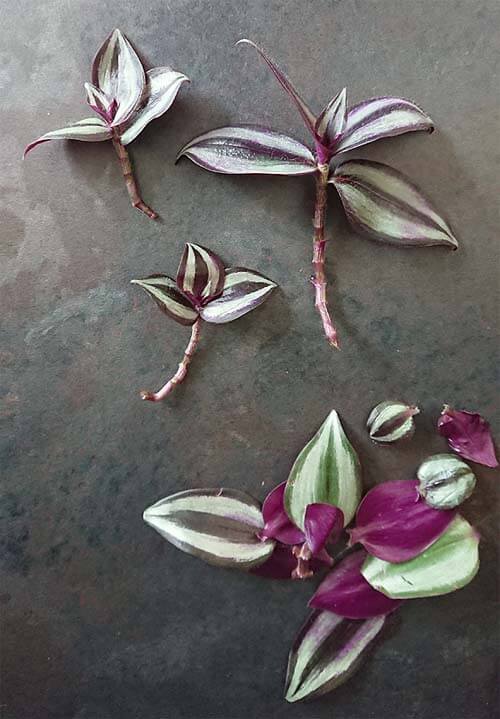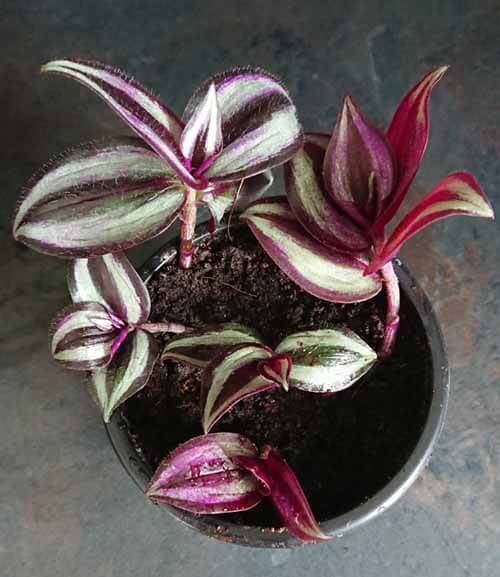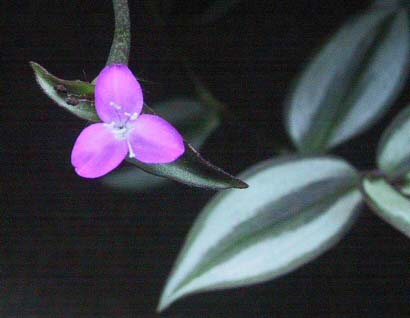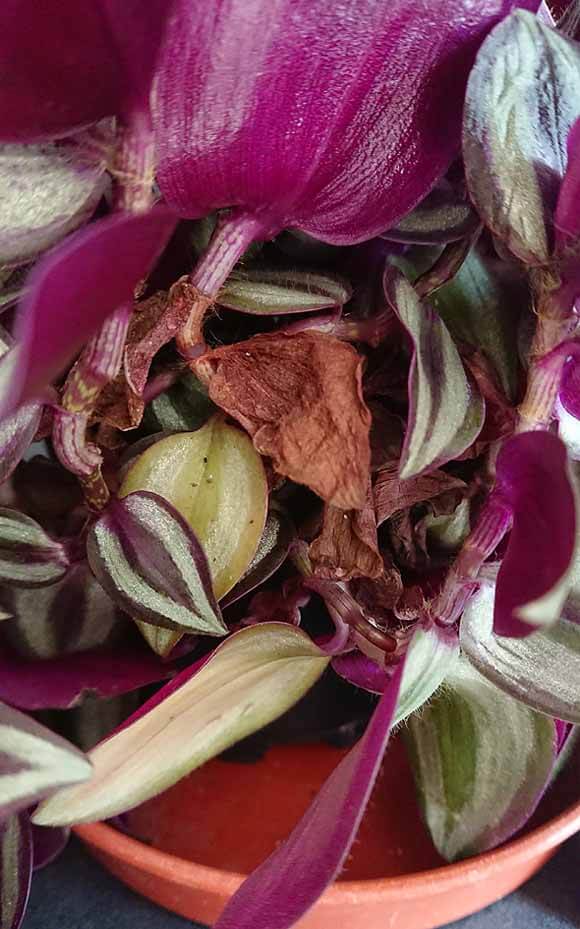The Wandering Jew, Wandering Dude, Inch Plant, Spiderwort or Tradescantia Zebrina is a houseplant that can be grown in a hanging basket to show off its long beautiful trailing vines or kept contained and compact in a pot.
Very versatile, very easy and very hard to finish off, makes this a very good indoor plant to have around.
Tradescantia make for excellent houseplants as they fit into almost any design scheme
"Wandering Jew Plant for sale" and "How do I care for my Wandering Jew plant?" are two big hitters when it comes to our visitors asking us questions about this popular and easy care houseplant. We would suggest Amazon.com or Amazon.co.uk or our Where to Buy article to kick start the buying hunt, and our article below will (hopefully) answer the care question for you.
The common names are based around the plant's ability to easily spread itself.
To start things off, a lot of people also want to understand the common names this plant goes by - the Wandering Jew Plant and the Inch Plant. Both names are centered around its ability to spread and grow very quickly, with little care or intervention from people.
Pro Tip - This is truly one of the simplest houseplants to propagate. From taking cuttings, you can have fully grown plants in less than 6 months.
The Wandering Jew is a legend that basically follows that a Jewish man was cursed to walk the earth forever, therefore like this plant the Jew will, in time, eventually go everywhere.
A number of visitors have contacted us to say the use of this common name today could be misconstrued or even upset Jewish people.
Unfortunately we've not been able to find any specific use of this common name being deliberately used by houseplant owners (or the horticultural industry in general) in an anti-Semitic way (from what we've seen at least). When talking about this plant directly even a Rabbi feels that the name is probably not used with conscious anti-Semitic malice.
That being said, the use and choice of words is often important. Our website is about houseplants and the joy they can bring, and without even trying, this hobby is a very inclusive pastime for everyone.
Our communication to you therefore should reflect this. We'll continue to monitor the common name and use one of the alternatives on our social media channels such as Wandering Dude.
The "inch" plant name probably comes from a combination of the stem's ability to grow about an inch every week, and also because only an inch of this plant is needed to propagate itself.
There are several popular varieties of Tradescantia Zebrina for sale each sharing the recognisable glistening leaf surface and purple underside. T. zebrina 'quadricolor' has green, silver, pink and red leaf markings, whereas T. zebrina 'purpusil' has a green and purple blend.
Tradescantia fluminensis is a very close relative to T. Zebrina (or Zebrina pendula as it used to be called) and is also known as the Wandering Jew Plant. Although it's much less popular these days, its care requirements are identical to T. Zebrina except it will cope better with a slightly darker position.
Where to Buy? - Where can you buy all these interesting varieties you ask, that's easy, check out these Etsy Sellers!*
You can also find a broad range as well as some more unusual types over on eBay*
* We'll sometimes earn a small commission when you buy something through the affiliate links on our site.
It has smaller leaves compared to its bigger cousin and more green in the leaves. T. fluminensis is therefore very plain looking so search out some of the varieties instead such as T. fluminensis 'variegata' or T. fluminensis 'quicksilver' or T. fluminensis 'Tricolor', these have cream and white stripes to give it a bit more of a visual punch.
You may find several types growing all in one pot for an extra hit. As the care requirements for each is pretty much the same you can leave them clustered together like this (providing you like this look of course).
Variegated Tradescantia are becoming much easier to find
We should mention that the Wandering Jew Plant outdoors tends to become an invasive species if not properly maintained, as it's difficult to eradicate because if only an inch of it survives it will live on.
That said, our focus is on the indoor grower and so its potentially invasive nature outdoors isn't a problem. The Wandering Jew Plant is safe to have around cats and people, the sap in the leaves and stems, however, can be irritating so either wear gloves or wash your hands immediately if you come into contact with this.

Hi, I'm Tom!
If you're like me and enjoy the challenge of growing houseplants and getting them to thrive, then Ourhouseplants can help. This website shares my knowledge and years of growing plants and provides (hopefully) helpful advice on properly caring for your indoor plant friends.
All Tradescantias including the Wandering Jew Plants need plenty of light to retain the variegated colours on the leaves, if things are too dim these will fade.
On the other side of the coin if too much light is provided leaf scorching is the end result, fortunately however the problem of "too much light" is basically only caused by excessively exposed locations during midsummer.
This is quite hard to provide indoors anyway, so you will only really risk this if you Summer your plants outdoors.
It's important they're placed in plenty of light but protected from very strong sun.
As you would expect from any easy houseplant, the Wandering Jew will cope with droughts and a little water logging from time to time.
Try to avoid this careless watering approach where possible though as a good looking plant needs to be watered correctly. The instruction here is simple, water your Tradescantia regularly and freely during the warmer seasons to try and keep the soil moist for much of the time.
In Winter cut right back because growth will slow or stop completely and the need for water will reduce drastically as a result.
The leaves are almost succulent like and therefore humidity is something you don't have to worry about a great deal. It will be worth misting the plant however if you start to notice the leaves becoming shriveled or brown leaf tips start to appear. You can also grow Tradescantia in an indoor bottle garden.
The opinion is often divided about how much and how often you should feed Wandering Jew Plants.
Some will suggest regular heavy feeding, perhaps as much as every other watering and others will say only once or twice a year at most, otherwise it will encourage the variegated leaves to turn green. The truth of it is that this plant will cope with almost anything you give (or don't give) it.
We fertilise normally (back of the bottle instructions) once a month and the OurHousePlant.com's Inch Plant is as good looking as the day it was brought.
Give your plant average warmth conditions for quick growth, a cooler room of around 10°C (50°F) is also suitable too. In fact, the only no no, is exposure to frost or really chilly temperatures for prolonged periods. Frost will do serious damage and chilly locations will cause leaf discoloration.
It's best to repot once a year to give a little more space for the roots to grow, but as with everything else to do with this plant, it will still cope living in the same soil for years. This is handy if you've chosen to grow it in a hanging basket as these can be fiddly to upsize and can also be a little difficult to work with.
When you do repot though, normal potting soil is a great choice, just make sure you avoid mixes with a heavy manure content and don't use ordinary dirt from your yard.
When it comes to propagation of Wandering Jews only the Spider Plant is easier and more reliable to work with. The success rate of Spider Plants is something like 99% and the Wandering Jew, 98%, so either way it's still incredibly easy to grow more plants.
You don't need a fancy heat mat or any special containers or tricks. You don't need to use any type of rooting hormone, and it's literally just a case of pushing the cutting a few centimeters into a fresh potting mix, water well and away you go. Trust us, once you know what you're doing it's so easy to do. Below is a break down of each step.
The stems of a mature plant are quite brittle so an accidental knock or an intentional snip on an existing plant will mean you have a Wandering Jew Plant stem cutting almost ready to go.
This broken stem can be used to create multiple plants
You don't need to wait for the fresh cut end to dry out so you could just push it into some soil (even in the existing pot where it was growing before if you're trying to recreate a bushy appearance).
But just replanting the large stem is potentially wasteful as there are several individual plants that can be created from a broken stem, like the one shown in the photo, this cutting could easily become three plants.
The photo above shows three sturdy stems with blue circles around them. Snip them off, making sure each is an inch long and has at least one leaf, although ideally for quicker results you will want a cutting that is several inches long and several leaves already in place.
Trim off any leaves on the lower part of the cuttings, because if any leaves touch the soil they will quickly rot, which could then cause the entire cutting to fail. Instead, remove the lower leaves and discard any unused material.
Below you can see the results of the above instructions - Three cuttings created from the original big one that are now ready to be planted up.
Several sections have been created and the lower leaves removed
Simply fill a container with potting soil or compost and wet it before inserting the stem ends into the soil. Make sure the cuttings are reasonably stable and fixed in place as they need good contact with the soil to stimulate root growth.
Pro Tip - Cuttings will take time to become bushy and to fill a pot by themselves, so because of the ease at which propagation can be done it's usually more effective to take several cuttings and put them all into the same pot.
You can use a rooting hormone, but we've found standard cuttings root with a very high probability anyway so don't bother.
Cuttings do much better if they don't touch each other and if they're planted towards the edges of the container rather than right in the center. Doing this will discourages rotting and the outer edges tend to be warmer than the very heart of the pot which gets the roots growing faster.
Once in place keep the soil moist (but not wet or soggy) and keep the plant warm. New growth should appear in just a few weeks. If you decided to grow several cuttings in a single pot and you notice any gaps later on, you can just push in new cuttings whenever needed to make it bushier.
The cuttings planted up into a pot of compost
You can, of course, grow your individual cuttings in their own pots if that's what you'd prefer to do, but by putting several together like in the photo above it will mean after just a few months this pot will be completely covered with new growth.
All these cuttings will have knitted together nicely to give the illusion of one full plant when in fact it's actually several. This is something that would take almost a year or more if you're going for one stem cutting per pot.
The growth rate of Wandering Jew Plants when temperatures are warm is fast. As much as an inch a week in the growing seasons, if good light levels are provided and its watering needs are being met.
Its natural tendency is to "vine" and spread out, so if you aren't growing this in a hanging basket or you want to grow a neat compact looking plant then you must prune regularly to keep it tidy (don't forget the pruned stems can be used to propagate new plants).
The height of this plant won't ever go beyond 6in / 15cm however every single stem can eventually grow to 6ft / 1.8M.
This type of spread might be what you're looking for of course i.e. if you want it to trail down from a hanging basket perched up high. However the stems can always be kept shorter by pinching out the growing tips on a frequent basis.
The Wandering Jew Plant is another houseplant that is grown for it's foliage rather than the flowers it produces, however they can still add a nice touch when they appear.
The pink or purplish flowers these plants produce will be small and can appear at any time of the year, although it's much more likely in late Spring early Summer.
Inch Plant's aren't normally grown for their flowers, but they'll still bloom indoors sometimes
Generally speaking, Tradescantia is very mildly toxic to pets and people.
While it does little harm if eaten, the sap within the leaves and stems can cause contact dermatitis on the skin, especially in those with sensitive skin or those with an allergy. Wash your hands quickly after handling and you shouldn't have any issues.
Your plant is looking tired, it's become leggy and unattractive, convinced you have done something wrong you Google "Wandering Jew care instructions" to try and find out how to fix things. The answer you'll find will be pretty much the same everywhere because as any seasoned owner of this plant will tell you, this "look" is inevitable.
The vines grow long and quickly. Over time as they age the older leaves yellow and fall off creating the appearance you feel you've caused through poor treatment, which isn't usually the case.
Basically what's happened is that the plant has pushed and spread itself away from the pot it was growing in.
You can start again by taking cuttings and next time prune more frequently to encourage everything to keep closer, compact and neat.
Good Light Needed To keep the beautiful markings you need to provide good to bright light. Avoid direct sun exposure and low light conditions.
Average Watering Tolerant of a wide range of watering styles, it secretly wants to be well watered and for the soil to be moist for much of the time.
Average Temperature Provide temperatures at or above 18°C (65°F) for best results.
Feeding Feed the soil once a month during Spring and Summer.
Leaf fall
Normally this is down to age, the oldest leaves will yellow and fall naturally. Although if this happens and you notice there are limp stems too then this is likely to be caused by quite prolonged and extreme underwatering.
Leaves changing to green / lost variegation
Although you can buy a green leaved variety of Wandering Jew, the majority are variegated and therefore if the leaves are changing colour this is obviously a problem.
The cause is almost certainly too little light. Overwatering can dull the colours but this doesn't make them go completely green. The cure therefore is to move the plant to a brighter area in your home.
Crispy brown and translucent leaves
Sometimes you'll find dead brown crispy leaves or some leaves going yellow or translucent, as shown in the photo below.
Tradescantia houseplant with unhappy leaves
This is going to be caused by one of the following (or in some cases a combination).
Stem rot
Wandering Jew Plants love water when growing strong, but as with the majority of indoor plants too much watering will eventually rot the stems. Keep the soil moist not water logged.
Bare spindly and / or leggy growth
This is typically the issue discussed in the "anything else" section above, i.e. this appearance is usual after the plant is quite old. It may also be caused however by too little light (the variegation will have faded also), too little water on a regular basis (accompanied with yellowing leaves), or not enough fertilizer.
Wandering Jew Plant leaf tips are brown and shriveled
Although quite unusual in most homes this is caused by placement in a room with very low humidity, i.e. the air is too dry. You might also be trying to grow your plant next to a heat source like a fire or heater.
Either move the plant somewhere else or follow some of our tips to increase humidity in the home. You should resolve this quickly as your Wandering Jew Plant will also be easy prey for Red Spider Mite infestation.
(Article / Gallery) Photo credit of the Wandering Jew T. fluminensi to LucaLuca
(Article / Gallery) Photo credit of the Wandering Jew flower to Ruestz
